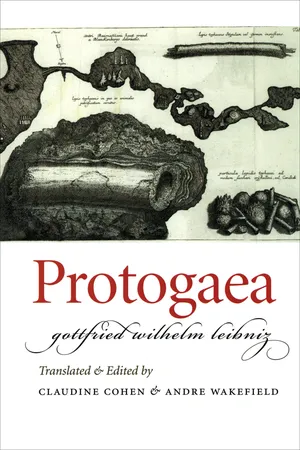
Protogaea
- English
- PDF
- Available on iOS & Android
About This Book
Protogaea, an ambitious account of terrestrial history, was central to the development of the earth sciences in the eighteenth century and provides key philosophical insights into the unity of Gottfried Wilhelm Leibniz's thought and writings. In the book, Leibniz offers observations about the formation of the earth, the actions of fire and water, the genesis of rocks and minerals, the origins of salts and springs, the formation of fossils, and their identification as the remains of living organisms. Protogaea also includes a series of engraved plates depicting the remains of animals—in particular the famous reconstruction of a "fossil unicorn"—together with a cross section of the cave in which some fossil objects were discovered.Though the works of Leibniz have been widely translated, Protogaea has languished in its original Latin for centuries. Now Claudine Cohen and Andre Wakefield offer the first English translation of this central text in natural philosophy and natural history. Written between 1691 and 1693, and first published after Leibniz's death in 1749, Protogaea reemerges in this bilingual edition with an introduction that carefully situates the work within its historical context.
Frequently asked questions
Information
Table of contents
- CONTENTS
- Acknowledgments
- Introduction
- PROTOGAEA
- i. Preamble
- ii. The first formation of the earth through fire
- iii. Different opinions concerning the creation of the globe
- iv. Sea salt, fires, and cycles of precipitation
- v. The many changes in our globe after its initial creation
- vi. What was the source of the water that covered the earth? And where did it go?
- vii. Bructerus and the origin of springs
- viii. Deposits of metal in the earth and a description of veins
- ix. The generation of minerals explained through chemistry
- x. Products common to laboratories and mines
- xi. The generation of precious stones, natural and artifi cial
- xii. Natural sublimations and the preparation of sal ammoniac
- xiii. It is through fire that metals appear in their proper forms
- xiv. Some bodies owe their form to the movement of waters
- xv. Some bodies coalesce in the waters
- xvi. Kinds of tuff stone formed by dripping water
- xvii. Some things arise from the combined action of heat and water
- xviii. Where do the shapes of various fi sh imprinted on slates come from?
- xix. Earthquakes, volcanoes, and other things show that there is fire inside our globe
- xx. The forms of fish imprinted on slate come from real fish, and are not games of nature
- xxi. The different layers of the earth, their locations, and the origin of salts and salt waters
- xxii. The origin of mountains and hills explained through waters, winds, and earthquakes
- xxiii. Marine shells are found throughout our region and elsewhere
- xxiv. The various kinds of shells were not created inside the stone, as is evident from their forms and positions
- xxv. The excavated shells and bones of marine animals can be identified as the parts of real animals
- xxvi. In ancient times, nearby seas contained animals and shellfish that are no longer found there
- xxvii. Glossopetrae, asterias, trochites, etc., are the remains of marine animals, and not games of nature
- xxviii. But it is wrong to include the polygonal shapes that can be found in crystals among these
- xxix. In which a certain lazy ingenuity, which invents things alien to truth, is rejected
- xxx. Where can the Lüneburg glossopetrae be found?
- xxxi. Glossopetrae are sharks’ teeth
- xxxii. The medical use of glossopetrae
- xxxiii. Belemnites, osteocolla, shell-filled stones, and fossil ivory
- xxxiv. Bones, jaws, skulls, and teeth found in our region
- xxxv. The unicorn’s horn, and an enormous animal unearthed in Quedlinburg
- xxxvi. Sharzfeld Cave and the bones that have been found in it
- xxxvii. The Baumann Cave and its contents
- xxxviii. On the nature of amber, especially the kind found in our region
- xxxix. Changes wrought by rivers and the vestiges of upheavals in our region
- xl. The struggle between sea and land
- xli. Sea and marsh once covered Venice and Este
- xlii. The marvelous fountains of Modena
- xliii. How Modena’s fountains are produced
- xliv. The layers of earth in Rosdorf, near Göttingen
- xlv. On buried trees and petrified wood
- xlvi. Peat and its origin
- xlvii. On trees buried underground
- xlviii. The layers of earth observed while digging a well in Amsterdam
- Appendix: Text from Friedrich Lachmund’s Oryktographia Hildesheimensis (1669)
- Glossary
- Bibliography
- Index